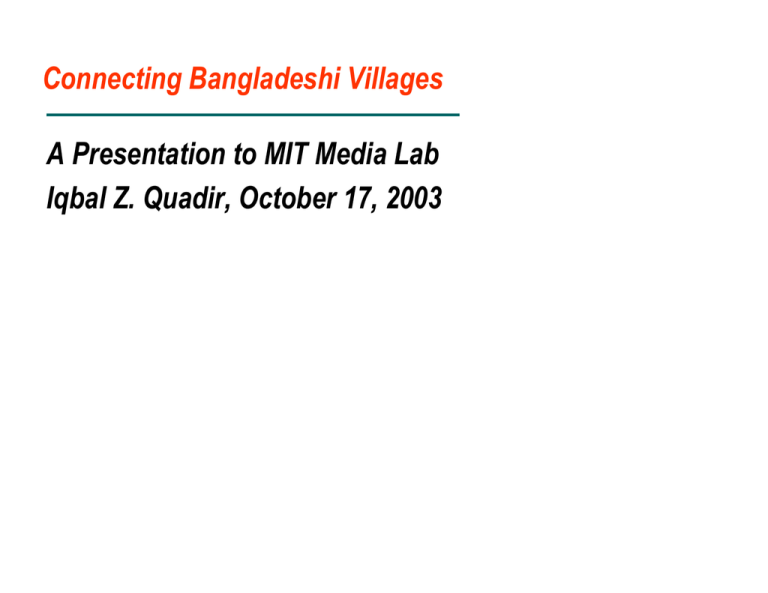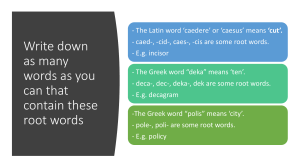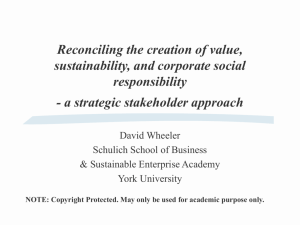Connecting Bangladeshi Villages A Presentation to MIT Media Lab
advertisement

Connecting Bangladeshi Villages A Presentation to MIT Media Lab Iqbal Z. Quadir, October 17, 2003 Financial Times, September 9, 2003 Arab world ‘held back by poor governance’ The linking of economic prosperity to political reforms will strike a particularly sensitive chord in the Arab world. Many regimes pride themselves on being good students of multilateral institutions and justify their absolute power on the grounds that they are best suited to provide economic and social development. William Easterly, former Senior Advisor The World Bank “ Many times over the last fifty years, we economists thought that we had found the right answer to economic growth. It started with foreign aid to fill the gap between “necessary” investment and saving….. Supplementing this idea was the notion that education was a form of accumulating “human machinery” that would bring growth. Next, concerned about how “excess” population might overwhelm the productive capacity of the economy, we promoted population control. Then, we realized government policies hindered growth, we promoted official loans to induce countries to policy reforms. Finally, when countries had trouble repaying their loans they incurred to do policy reforms, we offered debt forgiveness. None of these elixirs has worked as promised…” All these approaches looked at poverty in a top-down way (bird’s eye view dealing with the lives of worms) as if the poor is a target, not a resource as if wealth (better life) is something to be provided to the poor overlooking how economies actually evolved historically in developed countries. (It involved empowerment from below) overlooking the fact that engaging poor people in commerce contributes to strengthening of democracies (which can then lead to better societies and economies) Instead of seeing 2b mouths to feed, we need to think what we can do to make those • 2b brains to think for themselves • 4b eyes and ears to keep watch on governments • 4b hands and legs to move things The question How can we adopt “the worm’s eye-view”? Connectivity is productivity ITU research: Adam Smith: Specialization Productivity Specialization needs dependability Dependability needs connectivity Connectivity Connectivity Dependability Productivity Specialization Productivity Telecommunications in Bangladesh as of 1993 Only 2 phones per 1,000 people Virtually none in rural areas, leaving 100 million unserved $500 connection fee — and 5-10 years waiting period Most phones were analog and did not work A business opportunity The government is not building the necessary infrastructures. A part of the increased productivity could be channeled to pay for the service. A business needs to be (and can be) created Myths, facts and solutions Myths Lacking buyingpower, the poor provide no market. Facts Solutions Value (if higher than Production tools create buying power. costs) can get people ahead. Initial individual Shared-access buying power may reduces costs for be too low everyone. Meet primary needs first Community is the customer. A rise in income helps Ownership people meet primary empowers. needs. The real problem : A lack of other infrastructures Not Enough Grameen Bank •Records for credit checks. • 1138 Branches. •Roads for Repairman. • 12,801 employees. •Contact points for customer service. • 2.3 mill. borrowers. • 39,172 villages covered. •Banks to collect bills. • $33 mill. lent monthly. •Schools for children of workers. • 94% borrowers female. At this point, I learned to adopt the worm’s eye view from Grameen Bank Money Milk Money Money Money Service Money Money Mobilizing resources: 1993 - 1999 Current coverage of GrameenPhone Summary results of GrameenPhone Approaching $300 million in investment The expected 2003 net income (earnings after tax) is $60 million Largest telephone company in Bangladesh with 1,000,000 urban subscribers 33,000 villages served, giving telephone access to 50 million people in rural areas Revenues $100/month per village phone Profit of $2/day/phone, more than twice the per capita income Growth of Village Phones 25000 20000 15000 10000 5000 0 Dec- Jun- Dec- Jun- Dec- Jun- Dec- Jun- Dec- Jun- Dec- 397 98 98 99 99 00 00 01 01 02 02 Mar Increasing Incomes / Improving welfare Increasing incomes – generating profits for local entrepreneurs – farmers can get market information and better prices for crops – deals are being made over the phone Improving welfare – ability to call a doctor – can connect with urban or overseas relatives – substitutes for costly trip into capital city Design makes a difference Prior perceptions ¾ ¾ ¾ The poor is seen as the recipients Too expensive to provide services to the poor Enhancing skills is seen as a separate expensive project Post implementation ¾ ¾ ¾ Poor people is a resource Reduced cost of the service Skills of the poor enhanced






